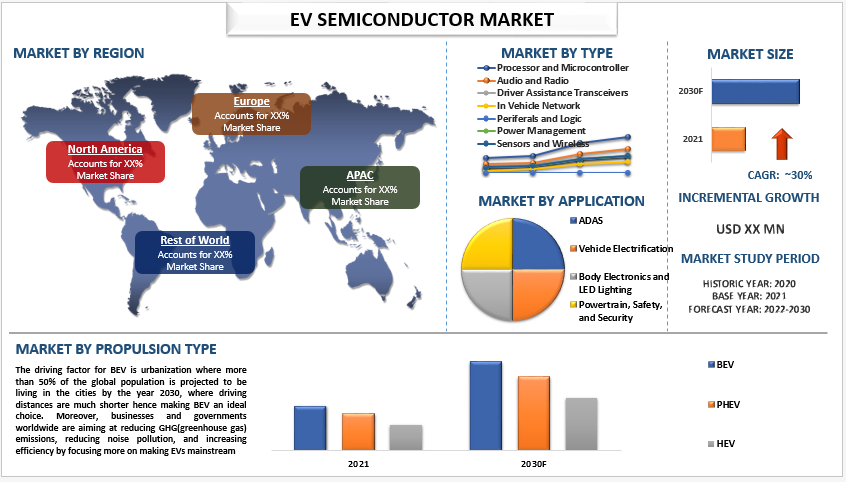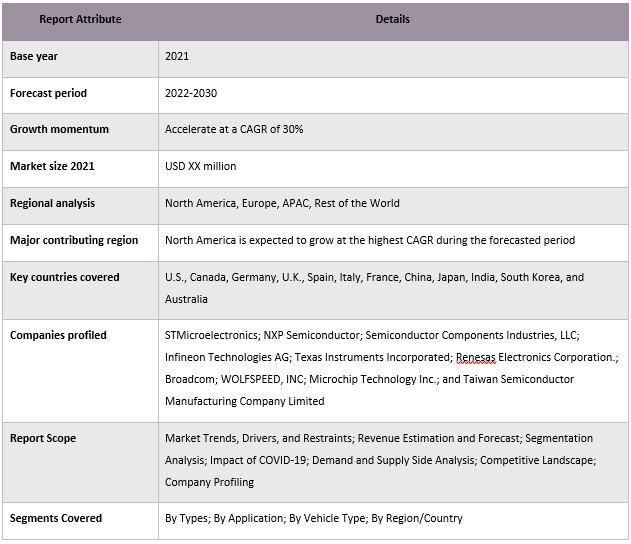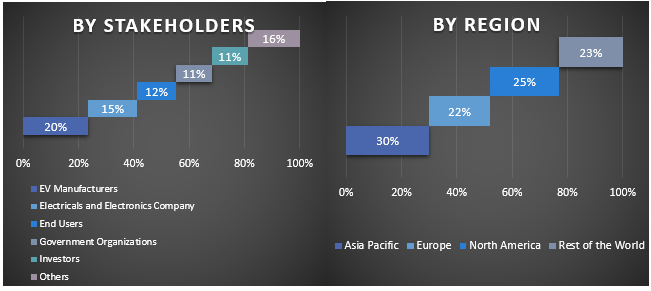EV Semiconductor Market: Current Analysis and Forecast (2022-2030)
$3999 – $6999
Emphasis on Types (Processors and Microcontrollers, Audio and Radio, Driver Assistance Transceivers, In-Vehicle Networks, Peripherals and Logic, Power Management, and Sensors and Wireless), Application (ADAS, Vehicle Electrification, Body Electronics, and LED Lighting, And Powertrain, Safety, And Security), Vehicle Type (BEV, PHEV, and HEV), and Region/Country.
| Pages: | 173 |
|---|---|
| Table: | 82 |
| Figure: | 106 |
| Report ID: | UMAU212130 |
| Geography: |

Report Description

The EV semiconductor market is expected to grow at a strong CAGR of around 30% during the forecast period 2022-2030. Dynamic changes are underway in the automotive industry which will have a huge impact on how cars will be built and used. The impact of this shift will be experienced by the automakers and the consumers and will be enabled by the semiconductor industry. And the factors that are being played out by four megatrends reshaping the automotive industry are autonomy, electrification, vehicle connectivity, and mobility services, and will lead to a plethora of changes in the role of electronics in automotive designs and will lift the semiconductor industry with it. Moreover, for long past automakers are steadily adding electronics to increase safety, enhance comfort, and improve the fuel efficiency of the vehicle, where advanced driver assistance features such as adaptive cruise control, lane departure warning system, or blind spot assist have become a piece of standard equipment in today’s vehicle. Furthermore, the use of electricals and semiconductors has more than doubled with today’s nontraditional powertrains used in hybrid and fully electric vehicles. Additionally, with increasing autonomy, autonomous vehicles are getting equipped with LiDAR sensors, image-recognition systems, and 5G communication will further eight or ten-fold increase the use of semiconductor content in vehicles, giving a boost to the demand for semiconductors in the automotive industry. For instance, even low-range vehicles of today come with at least 30 microprocessor-controlled devices also known as ECUs, and in luxury cars, the numbers could go upto even more than 100 ECUs, and Toyota high-end vehicles nowadays are coming packed with 100 million lines of computer code, more than even some fighter jets.
Some of the major players operating in the market include STMicroelectronics; NXP Semiconductor; Semiconductor Components Industries, LLC; Infineon Technologies AG; Texas Instruments Incorporated; Renesas Electronics Corporation.; Broadcom; WOLFSPEED, INC; Microchip Technology Inc.; and Taiwan Semiconductor Manufacturing Company Limited
Insights Presented in the Report
Based on application, the market is segmented into ADAS, vehicle electrification, body electronics and LED lighting, and powertrain, safety, and security. The ADAS segment is anticipated to contribute to the significant growth of the semiconductor industry in the forecasted period. The industry is pacing toward self-driving vehicles where Level 5 autonomy which has driverless cars are far in the future for mass-produced cars, but Level 4 autonomy in cars is expected to rise rapidly, which can complete a trip without a driver in a geo-fenced area and under speed limitations, and will appear in the next two or three years also in commercial fleet operations in urban markets. And semiconductor content in these vehicles is expected to rise eight to tenfold. Furthermore, electric vehicles will require a whole new level of connectivity, where vehicle telematics are continuously evolving to provide navigation, remote vehicle health monitoring, fleet vehicle tracking, and other communication-based services. And all these functions are going to drive the demand for the semiconductors, not just in the car itself but also in the required infrastructure. For instance, in April 2017, as per the Intel Editorial, four terabytes is the estimated amount of data that an autonomous car will generate in about an hour and a half of driving – or the amount of time a typical person spends in their car each day including navigation, guidance, infotainment, and other kinds of information, and will require a bulk amount of semiconductor chips in order to store, secure, transmit, and analyze these data with utmost reliability to guide safe vehicle performances.
“North America dominated the EV semiconductor market in 2021.”
The EV semiconductor market in the North American region held the largest market share and is expected to maintain its growth throughout the forecast period owing to several reasons such as increasing environmental consciousness among the populace, supportive government policies, technological advancements, and the increasing availability of the charging infrastructure. Moreover, major automakers are unveiling ambitious electrification plans, flooding consumers with choices as per their preferences which can also be seen in the sales data of electric vehicles in the North American region. For instance, in the first quarter of 2021, electric vehicle sales in the United States reached a record high of almost 100,000 units, representing a year-on-year growth of 80 percent and 20 percent of overall electric vehicles sold globally. And with this rising pace of electrification, semiconductors are the key enabler for this electrification drive. The demand for semiconductors is directly correlated with the rising demand and adoption of EVs. Furthermore, the demand for semiconductors will also come from many automotive-related applications, apart from the ones used in the vehicles such as EV charging infrastructure, sensors, and connectivity, V2X infrastructure, as well as servers to enable the cloud computing infrastructure that will be required for the autonomous vehicles.
EV Semiconductor Market Report Coverage

Reasons to buy this report:
- The study includes market sizing and forecasting analysis validated by authenticated key industry experts.
- The report presents a quick review of overall industry performance at one glance.
- The report covers an in-depth analysis of prominent industry peers with a primary focus on key business financials, product portfolios, expansion strategies, and recent developments.
- Detailed examination of drivers, restraints, key trends, and opportunities prevailing in the industry.
- The study comprehensively covers the market across different segments.
- Deep dive regional level analysis of the industry.
Customization Options:
The global EV semiconductor market can further be customized as per the requirement or any other market segment. Besides this, UMI understands that you may have your own business needs, hence feel free to connect with us to get a report that completely suits your requirements.

You can also purchase parts of this report. Do you want to check out a section wise
price list?
Research Methodology
Research Methodology for the EV Semiconductor Market Analysis (2022-2030)
Analyzing the historical market, estimating the current market, and forecasting the future market of the global EV semiconductor market were the three major steps undertaken to create and analyze the adoption of the EV semiconductor in major regions globally. Exhaustive secondary research was conducted to collect the historical market numbers and estimate the current market size. Secondly, to validate these insights, numerous findings and assumptions were taken into consideration. Moreover, exhaustive primary interviews were also conducted, with industry experts across the value chain of the global EV semiconductor market. Post assumption and validation of market numbers through primary interviews, we employed a top-down/bottom-up approach to forecasting the complete market size. Thereafter, market breakdown and data triangulation methods were adopted to estimate and analyze the market size of segments and sub-segments of the industry pertains to. Detailed methodology is explained below:
Analysis of Historical Market Size
Step 1: In-Depth Study of Secondary Sources:
Detail secondary study was conducted to obtain the historical market size of the EV semiconductor market through company internal sources such as annual reports & financial statements, performance presentations, press releases, etc., and external sources including journals, news & articles, government publications, competitor publications, sector reports, third-party database, and other credible publications.
Step 2: Market Segmentation:
After obtaining the historical market size of the EV semiconductor market, we conducted a detailed secondary analysis to gather historical market insights and share for different segments & sub-segments for major regions. Major segments are included in the report as by type, by application, and by vehicle type. Further country-level analyses were conducted to evaluate the overall adoption of testing models in that region.
Step 3: Factor Analysis:
After acquiring the historical market size of different segments and sub-segments, we conducted a detailed factor analysis to estimate the current market size of the EV semiconductor market. Further, we conducted factor analysis using dependent and independent variables such as by type, by application, and by vehicle type of the EV semiconductor market. A thorough analysis was conducted for demand and supply-side scenarios considering top partnerships, mergers and acquisitions, business expansion, and product launches in the EV semiconductor market sector across the globe.
Current Market Size Estimate & Forecast
Current Market Sizing: Based on actionable insights from the above 3 steps, we arrived at the current market size, key players in the global EV semiconductor market, and market shares of the segments. All the required percentage shares split and market breakdowns were determined using the above-mentioned secondary approach and were verified through primary interviews.
Estimation & Forecasting: For market estimation and forecast, weights were assigned to different factors including drivers & trends, restraints, and opportunities available for the stakeholders. After analyzing these factors, relevant forecasting techniques i.e., the top-down/bottom-up approach were applied to arrive at the market forecast for 2030 for different segments and sub-segments across the major markets globally. The research methodology adopted to estimate the market size encompasses:
- The industry’s market size, in terms of revenue (USD) and the adoption rate of the EV semiconductor market across the major markets domestically
- All percentage shares, splits, and breakdowns of market segments and sub-segments
- Key players in the global EV semiconductor market in terms of products offered. Also, the growth strategies adopted by these players to compete in the fast-growing market
Market Size and Share Validation
Primary Research: In-depth interviews were conducted with the Key Opinion Leaders (KOLs) including Top Level Executives (CXO/VPs, Sales Head, Marketing Head, Operational Head, Regional Head, Country Head, etc.) across major regions. Primary research findings were then summarized, and statistical analysis was performed to prove the stated hypothesis. Inputs from primary research were consolidated with secondary findings, hence turning information into actionable insights.
Split of Primary Participants in Different Regions

Market Engineering
The data triangulation technique was employed to complete the overall market estimation and to arrive at precise statistical numbers for each segment and sub-segment of the global EV semiconductor market. data was split into several segments & sub-segments post studying various parameters and trends in the areas of by type, application, and by vehicle type in the global EV semiconductor market.
The main objective of the Global EV Semiconductor Market Study
The current & future market trends of the global EV semiconductor market were pinpointed in the study. Investors can gain strategic insights to base their discretion for investments on the qualitative and quantitative analysis performed in the study. Current and future market trends determined the overall attractiveness of the market at a regional level, providing a platform for the industrial participant to exploit the untapped market to benefit from a first-mover advantage. Other quantitative goals of the studies include:
- Analyze the current and forecast market size of the EV semiconductor market in terms of value (USD). Also, analyze the current and forecast market size of different segments and sub-segments
- Segments in the study include areas by type, by application, and by vehicle type.
- Define and analysis of the regulatory framework for the EV semiconductor market
- Analyze the value chain involved with the presence of various intermediaries, along with analyzing customer and competitor behaviors of the industry
- Analyze the current and forecast market size of the EV semiconductor market for the major region
- Major countries of regions studied in the report include Asia Pacific, Europe, North America, and the Rest of the World
- Company profiles of the EV semiconductor market and the growth strategies adopted by the market players to sustain in the fast-growing market
- Deep dive regional level analysis of the industry

You can also purchase parts of this report. Do you want to check out a section wise
price list?
You must be logged in to post a review.



Reviews
There are no reviews yet.